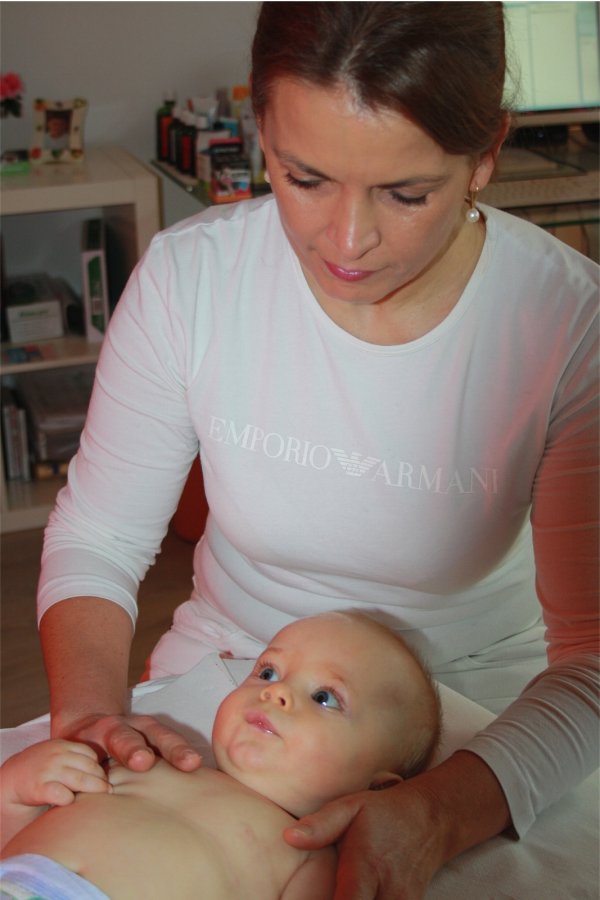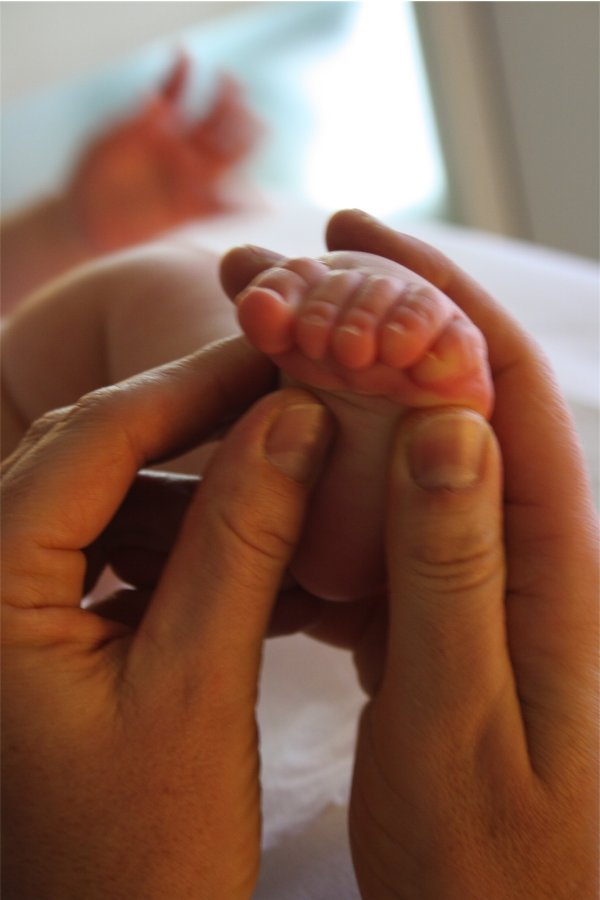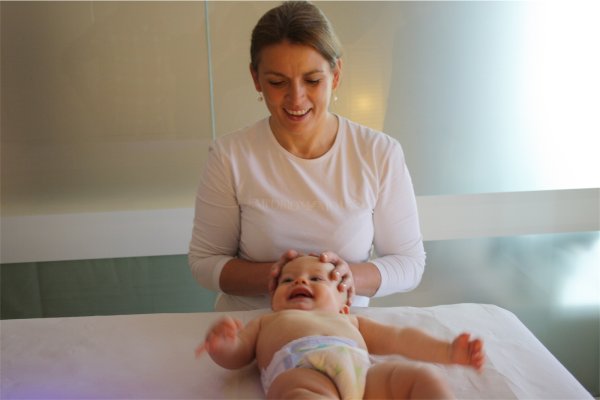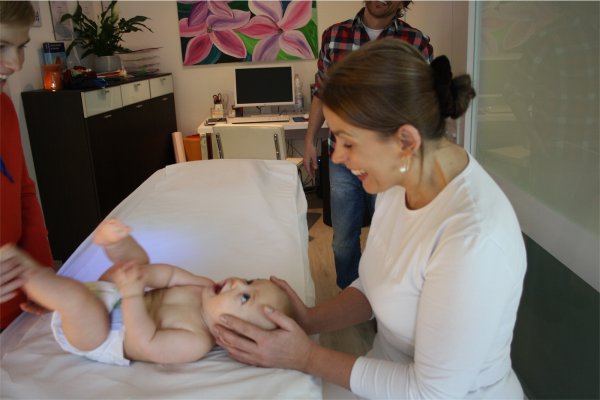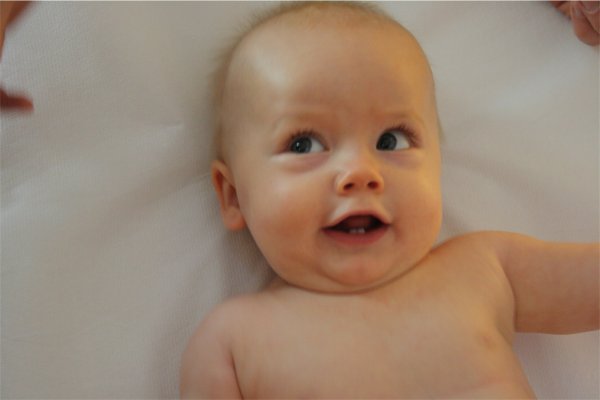There are many things that can disrupt the harmonic interplay between the individual body structures: a difficult birth, falls and other accidents, infections and even prenatally due to problems during pregnancy.
Functional disturbances in infants are usually caused by pressure from the mother's body through spatial narrowing, by premature labor and, during the birth, by narrowing of the birth canal – often resulting in skull deformations and resulting tensions of the brain membranes.
The symptoms can be extremely varied:
- Treatment of birth trauma caused by births that happen to quickly, suction cups or excessive compression in the birth canal. Children born by caesarean section, too, can suffer from the rapid transition from the carefree protection inside the mother’s body into the comparatively rough and cold outside world.
- Preference for one side after clavicle fractures = bruise fracture during birth
- Solving side preferences. Infants with a tendency to look only to one side often flatten one side of their heads. As a result, the take in information only on one side. Empirically, over the past ten years, I have noticed that one-sided head rotations are associated with digestive complaints and/or sleep disorders.
- Preference for one breast while breastfeeding can indicate blockages in the upper head joints
- Treatment of tear duct stenosis
- Tone regulation: the state of muscular tension in hypotonic children is increased and reduced in hypertonic children.
- Training of the infant to be aware of both sides of the body
- Stimulation of the facial area, especially the mouth
- Treatment of the oral cavity
- Improved capacity for sucking and swallowing
- Optimizing respiratory function
- Optimizing resolution of secretions
- Optimizing transportation of secretions
- Physiological thoracic mobility
- Increasing of immune defense
- Advice about bedding for and carrying of an infant
- General advice to the mother and father about handling and holding of the baby. Well-functioning and stress-free interaction between parent and child forms the basis for healthy development.
Physiotherapy and osteopathy for infants
Handling of newborns and premature babies
Parents are shown how best to support the physiological development of their baby, in terms of day-to-day handling. Parents can also specifically address motor abnormalities, e.g. one-sided head rotation, preference for one side, non-physiological stretching or flexion positions and learn how to handle them on a daily basis.
Basic stimulation
Basic stimulation offers the child tactile, proprioceptive as well as vestibular stimuli. This promotes sensitivity, depth sensitivity and balance.
Tone regulation
Through physiotherapeutic and osteopathic treatment, the muscular stress state can be increased in hypotonic children (for example, in “floppy” infants) and reduced in hypertonic children (for example, when spasticity is present).
Baby massage
Tactile stimulation increases an infant’s perception and improves how his or her body feels. Parents can also learn baby massage techniques.
Orofacial osteopathic therapy
Orofacial therapy involves stimulation of the facial area, especially the mouth. It targets the shoulder girdle, the head and cervical spine, as well as the expressive musculature. Building upon this, stimulation of the mouth and movement of the jaw mechanism takes place. Treatment of the oral cavity improves capacity for sucking and swallowing.
Initiation of physiological movement patterns
Sensory stimuli are used to create a basis for developmental movements. They represent a basis on which the child himself or herself can develop motor development. The treatment concept is based upon Bobath.
Respiratory therapy
This therapy deepens the infant’s breathing, thus increasing intake of oxygen. Cleansing of the lungs is supported through removal and transportation of mucus. The importance of this becomes obvious when one considers that the infant is supplied with oxygen by the umbilical cord in the mother's womb and the lungs are thus switched on to receiving oxygen from the air upon birth.
The therapy aims at prophylaxis of postural disorders in adulthood, and optimal use of the resources a person brings into the world, in harmony with his or her surroundings.
In order to be able to handle babies in a highly conscientious way, I have taken a wide variety of training courses since 1990, starting with Bobath at Ulm University Hospital, Vojta in Karlsruhe, osteopathy for infants in Ghent and integrative osteopathy in Frankfurt. The topics of these continuing-education courses included:
- Pregnancy and birth: the osteopathic and the medical way; the newborn: medical and osteopathic insights
- Normal development of the child and newborn; the body’s sensory instruments from a medical point of view
- Key embryological knowledge
- Motor and sensory development in children; osteopathic treatment of children
- Internal organs
- Help with infants and children
- Neuroendocrinology: the medical and osteopathic approach
- Immune system and premature birth: medical and osteopathic approach | 1
- The sensory instruments of the body from an osteopathic point of view
- Orthopedics and the temporomandibular joint: the medical and osteopathic approach | 2 days Learning and behavioral problems: the medical and osteopathic approach
- Hereditary diseases and the disabled child
- Practical clinic management
- Methodology and statistics
